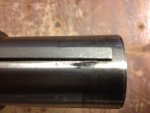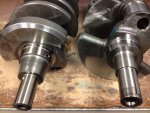Hi Guys,
This was asked on another thread...
http://www.fordgtforum.com/forums/showthread.php?23987-End-of-ethanol/page4
... I thought it more appropriate to be answered here since this is similar to what is going to happen Mark's GT.
MoTec Magic - thanks 4 the info :thumbsup when it comes time for me to upgrade my fuel system for whatever reason i now know who to call :cheers i assume you guys do nitrous installations too for use with race gas?
Yes... gasoline, ethanol, or methanol.
My preference is to do a "dry" shot, where the nitrous fuel is added through the main fuel injectors... controlled by a MoTeC ecu. There are some significant advances in nitrous technology lately. To run nitrous the most efficiently when looking to make big power... you need to be able to modulate the amount of nitrous going into the motor. Most people and or teams running big nitrous applications will run either multiple stages of nitrous where you have several different solenoids and you simply turn one on or off depending on how much power you want. This produces a square wave step in power... not ideal unless introduced on a gear change. Others that don't use staged nitrous will pulse the solenoid more or less to control the power level... this is less than ideal because the nitrous is pulsing and it isn't sequential with the cylinders like your fuel injectors are, so you can see how the delivery of nitrous would be inconsistent from cylinder to cylinder.
The new way is with variable orifice valves. We control how far open the nitrous valve is at any given time. This allows us to deliver smooth, non pulsed, nitrous at infinite power levels. On a big nitrous application we can go from 0-500hp or anywhere in-between at any time. We can do 0-300 too.
On a dual power adder application where we have turbo nitrous or blower nitrous here's how I would do this:
(This requires an aftermarket controller, preferably a MoTeC with gear detection... this is how I would set up a TT application... SC will be slightly different,)
A properly controlled system will allow the driver to WOT from a stand still through the entire pull regardless of gear.
Launch control setup allows WOT and clutch dump from standstill. Computer controls allowed wheel spin so that the car accelerates consistently. Once the car leaves or is already rolling, race grade traction control is the safety net if the car should try to spin the tires in any gear at WOT.
1st gear... nitrous will activate at WOT if the clutch is not engaged... boost control valve open for lower boost level... nitrous will come in full 100-150hp shot depending on traction but will ramp out as boost ramps in. At peak boost in 1st, nitrous will turn off... driver is WOT all of 1st gear.
2nd gear... after the gear change, nitrous will reactivate 200-300hp and will again ramp out as boost increases... nitrous will turn off at peak boost... boost control valve open slightly... WOT, TC saftey net
3rd gear... after the gear change, nitrous will reactivate 300hp and will again ramp out as boost increases, it may not ramp out entirely depending on power level desired... boost control most likely closed... WOT, TC safety net
4th gear... after the gear change, nitrous will reactivate 300hp and will again ramp out as boost increases, it may not ramp out entirely depending on power level desired... boost control valve is most likely closed at this point... WOT, TC safety net
5th gear... after the gear change, nitrous will reactivate 300hp and will again ramp out as boost increases, it may not ramp out entirely depending on power level desired... boost control valve is most likely closed at this point... WOT, TC safety net
6th gear... after the gear change, nitrous will reactivate 200hp and will again ramp out as boost increases, it may not ramp out entirely depending on power level desired, however the car has run hard for quite a while at this point, reducing the heat by reducing or turning off nitrous in high gear is advised... boost control valve is most likely closed at this point... WOT, TC safety net
The fact is that the large majority of GT owners won't be in 6th gear... at least with stock gearing. A few will and the option to run however much nitrous is needed is obviously available. Hope this paints a clear picture as to what is possible. Other strategies are possible this is just my preferred approach.
The biggest benefit here is for eliminating boost lag by using a fairly good sized shot of nitrous but having the ability to back it out in the lower gears so that there aren't traction issues.
Cheers



